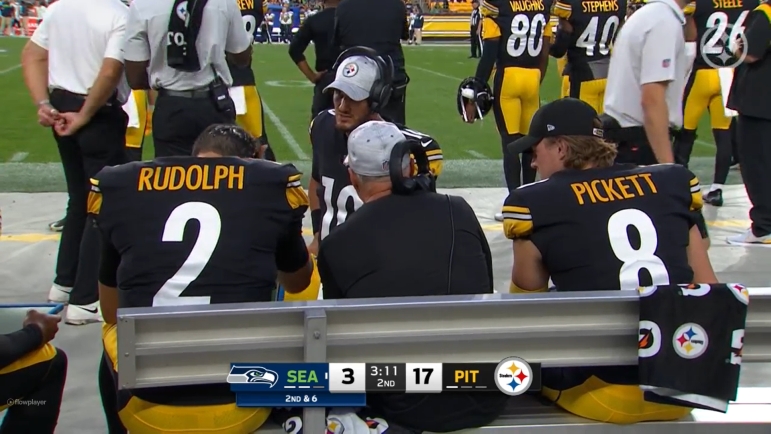Late in the 2023 NFL season, the Pittsburgh Steelers had their two highest-scoring offensive games of the season with QB Mason Rudolph under center. He led the Steelers to 34 points versus the Cincinnati Bengals, then 30 points the following week at the Seattle Seahawks. Those two games were the only times the Steelers put up at least 30 points in the season. Even their third-best score came back in Week Two when the defense scored two touchdowns.
So it was no surprise that head coach Mike Tomlin was asked about Rudolph’s performance in his end-of-year press conference. Specifically, he was asked if the playcalling changed with Rudolph at quarterback. His response emphasized that the situation called for more aggression, according to video shared by the team’s YouTube channel.
“He performed well, but our intentions were our intentions,” Tomlin said. “There was no tomorrow, and so we were aggressive in nature and in about every component of what it is that we did over that stretch.”
Tomlin was pressed with a follow-up question about whether the team’s earlier offensive philosophy emphasized cutting down on turnovers too much over scoring points, but he declined to answer that, stating that “I’ll assess all of those things, but we’re just at the very infancy of reviewing.”
Being aggressive late in the season makes complete sense. The Steelers’ playoff hopes were on the ropes, so they needed to win every game in front of them and still get help. That all happened, thanks in large part to the offense coming alive with Rudolph (and the Jacksonville Jaguars falling to the curse of the Terrible Towel.)
So what does the data say? Did the Steelers begin to press more with Rudolph at quarterback than they did earlier in the season with Kenny Pickett starting (or even Mitchell Trubisky?) There are a few data points to hit that can help shed some light, starting with some advanced statistics aimed at seeing how far quarterbacks are throwing the ball.
Intended Air Yards Per Pass Attempt (Or IAY/PA)
Now don’t let your eyes glass over. This is simply a metric of how far the quarterback is throwing the ball every pass attempt, regardless of whether it’s completed, incomplete, or intercepted. Arguably, the more aggressive an offense is, the further they are attempting to push the ball down the field.
So with that in mind, if the Steelers are being more aggressive and attempting to put more points on the board, it would stand to reason that Rudolph’s IAY/PA would be higher than Pickett’s, correct?
Yet the quarterbacks had the same exact IAY/PA, 7.0. That means, on average, both Pickett’s and Rudolph’s passes traveled seven yards from the line of scrimmage through the air. So in terms of that statistic, both quarterbacks are equally as aggressive in pushing the ball down the field. One other quarterback in the NFL had the same mark, Geno Smith of the Seattle Seahawks.
Does that paint the whole picture, though? No. One important part of the puzzle is that Rudolph’s third start was Week 18 at the Baltimore Ravens in much-less-than-ideal weather conditions. So let’s take a look at individual games to see if that paints a better picture.
In 2023, Rudolph’s season-high IAY/PA was 9.2 yards in the 34-11 win over the Bengals (his first start of the season.) Pickett edged Rudolph out with an IAY/PA of 9.5 yards in the 17-10 win over the Ravens in Week Five.
Then when you compare the two quarterbacks’ second-best totals, the difference becomes even more interesting. Pickett had an IAY/PA of 8.5 yards twice in 2023. In fact, he had five total games with an IAY/PA of 8.0 yards or higher. Rudolph’s second-highest was 7.6 yards against the Seahawks. He only averaged 3.6 yards through the air against the Ravens in Week 18, largely due to the weather.
So statistically, it appears that Pickett was actually a bit more aggressive in terms of attempting passes downfield. He also attempted 32 passes in the game against the Ravens as well as 33 against the Bengals. So not only was Pickett being aggressive pushing the ball down the field more, he was doing that while attempting a decent volume of passes. For comparison, Rudolph did not attempt 30 passes or more during his three regular-season starts in 2023.
For more context, we pull in the derivatives of IAY/PA. When we look at Completed Air Yards Per Completion, or how many air yards on average a completion covered, a little bit of separation opened between Rudolph and Pickett, 5.3 yards to 5.1. Not major, but worth noting.
The picture becomes more apparent when we look at the CAY/PA statistics. This compares the average of air yards per completion versus the number of pass attempts. It gives a more complete picture of how well the quarterback is throwing the ball down the field.
Pickett’s season-long CAY/PA is 3.1 yards, while Rudolph averaged 4.0 yards. Pickett’s number leaves him tied for 24th out of 32 qualifying quarterbacks with Sam Howell of the Washington Commanders, New York Jets QB Zach Wilson, and Arizona’s Kyler Murray. Only five quarterbacks posted a lower CAY/PA than Pickett in 2023. Rudolph would be tied for ninth-highest in the league with six other quarterbacks if he had enough attempts to qualify.
So while there isn’t a major disparity in terms of how far each quarterback is throwing the ball through the air, it does appear that Rudolph is much more productive doing so than Pickett. (An aside: the Steelers’ offensive weapons also averaged more yards after the catch for Rudolph than Pickett. That’s not exactly sustainable, but it is interesting.)
Average Depth Of Target (And Target Volume)
Another way of looking at how aggressive the offense was or wasn’t is by looking at the pass catchers. WR George Pickens, WR Diontae Johnson, and TE Pat Freiermuth were the only pass catchers who caught multiple touchdowns during 2023 (WR Calvin Austin III also caught one touchdown.) So how did they fare in Weeks 1-15 versus the final three weeks with Rudolph?
Across the board, all three had their deepest Average Depth Of Target, or ADOT, as receivers for Pickett or Trubisky, not Rudolph. Pickens had his highest ADOT against the Indianapolis Colts in Week 14, while both Johnson and Freiermuth were earlier. All three pass catchers had their season-highs for targets earlier in the season as well.
So Pickens, Johnson, and Rudolph were not targeted at their highest rates nor their furthest points downfield over the final three weeks of the season. Pickens did have an above-average ADOT against the Bengals with Rudolph, and Freiermuth did as well against the Ravens in Week 18.
So were the Steelers producing at a higher rate because Rudolph was simply better at being aggressive and pushing the ball down the field? Not necessarily. There is one other bit of information that plays a role in the formula.
Deep Passing Percentages
We’ve been looking at the averages, but what about the percentage of deep shots down the field?
For the season, Pickett attempted a deep shot on 8.6 percent of his passing attempts. Rudolph, in the regular season, attempted a deep shot 12.7 percent of the time. If you remove the weather-affected Week 18 game, Rudolph was throwing a deep pass 15.7 percent of the time against the Bengals and Seahawks. In fact, Rudolph attempted deep shots on 18.5 percent of his throws against the Bengals, almost a full 10 percent more than Pickett’s average. That does speak to a more aggressive mentality in terms of playcalling.
And it doesn’t hurt that Rudolph, on average, was better at completing those longer shots down the field than Pickett, either.
So did the Steelers perform better at the end of the season simply because they were more aggressive with attacking downfield? Or was it because Rudolph was the one attempting the higher amount of deep shots? Like most things in life, it looks like it might be a little bit of both.









